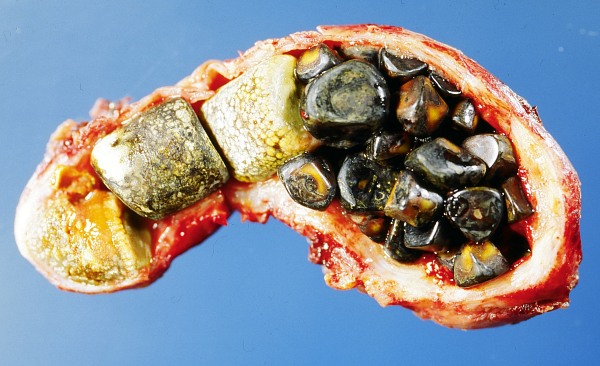Gallstone disease pathophysiology
| https://https://www.youtube.com/watch?v=UPw3ot1M_o0%7C350}} |
|
Gallstone disease Microchapters |
|
Diagnosis |
|---|
|
Treatment |
|
Surgery |
|
Case Studies |
|
Gallstone disease pathophysiology On the Web |
|
American Roentgen Ray Society Images of Gallstone disease pathophysiology |
|
Risk calculators and risk factors for Gallstone disease pathophysiology |
Editor-In-Chief: C. Michael Gibson, M.S., M.D. [1]; Associate Editor(s)-in-Chief: Hadeel Maksoud M.D.[2]
Overview
It has long been noted that gallbladder stone formation is associated with bile supersaturation, and this still remains the most common cause for gallstone formation.[1]
Pathophysiology

Researchers believe that gallstones may be caused by a combination of factors, including:
- Inherited body chemistry
- Body weight
- Gallbladder motility
- Diet
- Erythropoietic protoporphyria[3]
Cholesterol gallstones develop when bile contains too much cholesterol and not enough bile salts. The following factors also play a role:
- Gallbladder contraction
- Incomplete and infrequent emptying concentrates bile
- Presence of proteins in the liver and bile causing either promotion or inhibition of cholesterol crystallization into gallstones
- Increased levels of the estrogen hormone may increase cholesterol levels in bile and also decrease gallbladder movement
No clear relationship has been proven between diet and gallstone formation. However, low-fiber, high-cholesterol diets, and diets high in starchy foods have been suggested as contributing to gallstone formation. Other nutritional factors that may increase risk of gallstones include rapid weight loss, constipation, eating fewer meals per day, eating less fish, and low intakes of the nutrients folate, magnesium, calcium, and vitamin C.[4] On the other hand, wine and whole grain bread may decrease the risk of gallstones.[5]
Associated Conditions
- Diabetes Mellitus Type 2[6]
- Obesity
- Pregnancy
- Gallbladder Cancer
- Gallbladder Polyps
- Primary Sclerosing Cholangitis
- Porcelain Gallbladder
Gross Pathology
On gross pathology, multiple small stones are commonly found or less commonly a solitary stone is seen. The smaller stones represent a higher morbidity since they can easily occlude the biliary tracts.[7]
Microscopic Pathology
On microscopic histopathological analysis, variable evidences of inflammation can be noted transmurally including neutrophils, which are characteristic in gallstone disease.[8]
References
- ↑ Wang HH, Portincasa P, Wang DQ (2008). "Molecular pathophysiology and physical chemistry of cholesterol gallstones". Front. Biosci. 13: 401–23. PMID 17981556.
- ↑ name="urlFile:Gallensteine 2006 03 28.JPG - Wikimedia Commons">"File:Gallensteine 2006 03 28.JPG - Wikimedia Commons".
- ↑ "Erythropoietic Protoporphyria". Merck Manual. Retrieved 2007-08-25.
- ↑ R.M. Ortega (1997). "Differences in diet and food habits between patients with gallstones and controls". Journal of the American College of Nutrition. 16: 88–95. Unknown parameter
|month=ignored (help); Unknown parameter|coauthors=ignored (help);|access-date=requires|url=(help) - ↑ European Journal Gastroenterology & Hepatology. 6: 585–593. 1995. Unknown parameter
|month=ignored (help);|access-date=requires|url=(help) - ↑ Lv J, Yu C, Guo Y, Bian Z, Yang L, Chen Y, Li S, Huang Y, Fu Y, He P, Tang A, Chen J, Chen Z, Qi L, Li L (2017). "Gallstone Disease and the Risk of Type 2 Diabetes". Sci Rep. 7 (1): 15853. doi:10.1038/s41598-017-14801-2. PMID 29158491.
- ↑ Ansert, Sandra (2018). Textbook of diagnostic sonography. St. Louis, MO: Elsevier. ISBN 978-0323353755.
- ↑ Fisher, M. M. (1979). Gallstones. Boston, MA: Springer US. ISBN 1461570662.